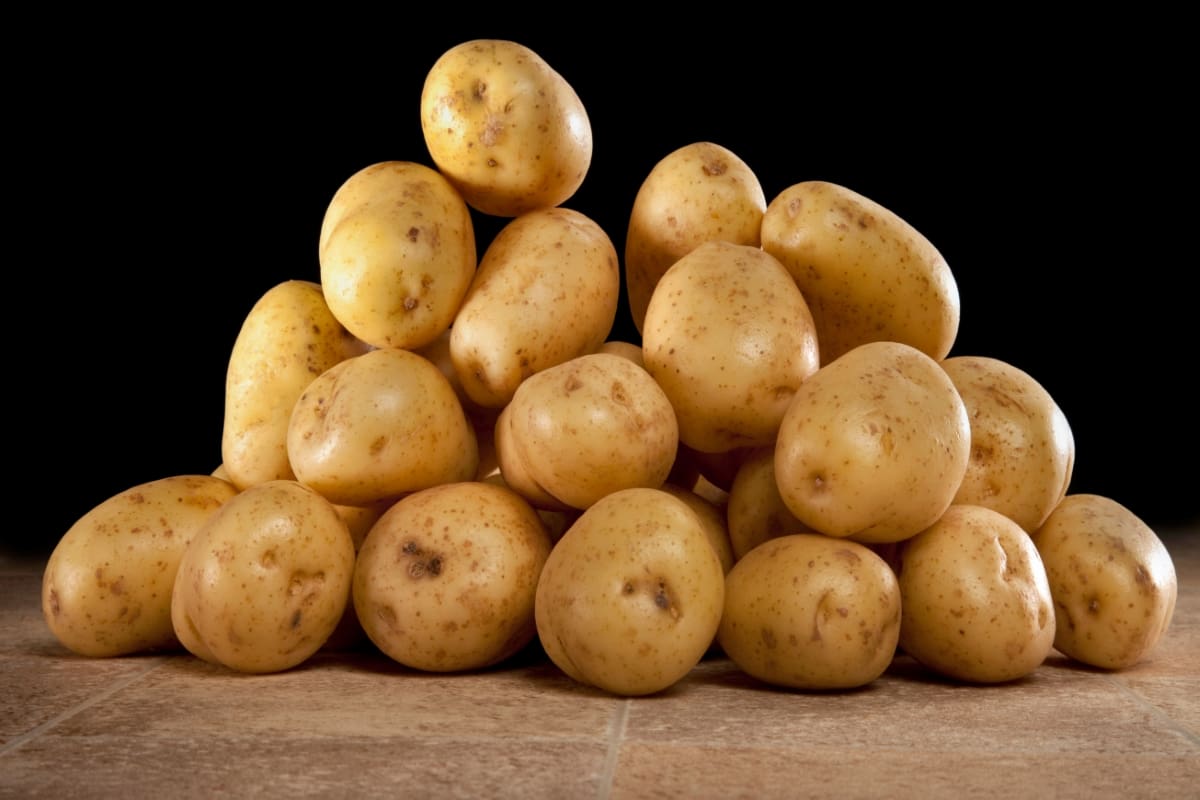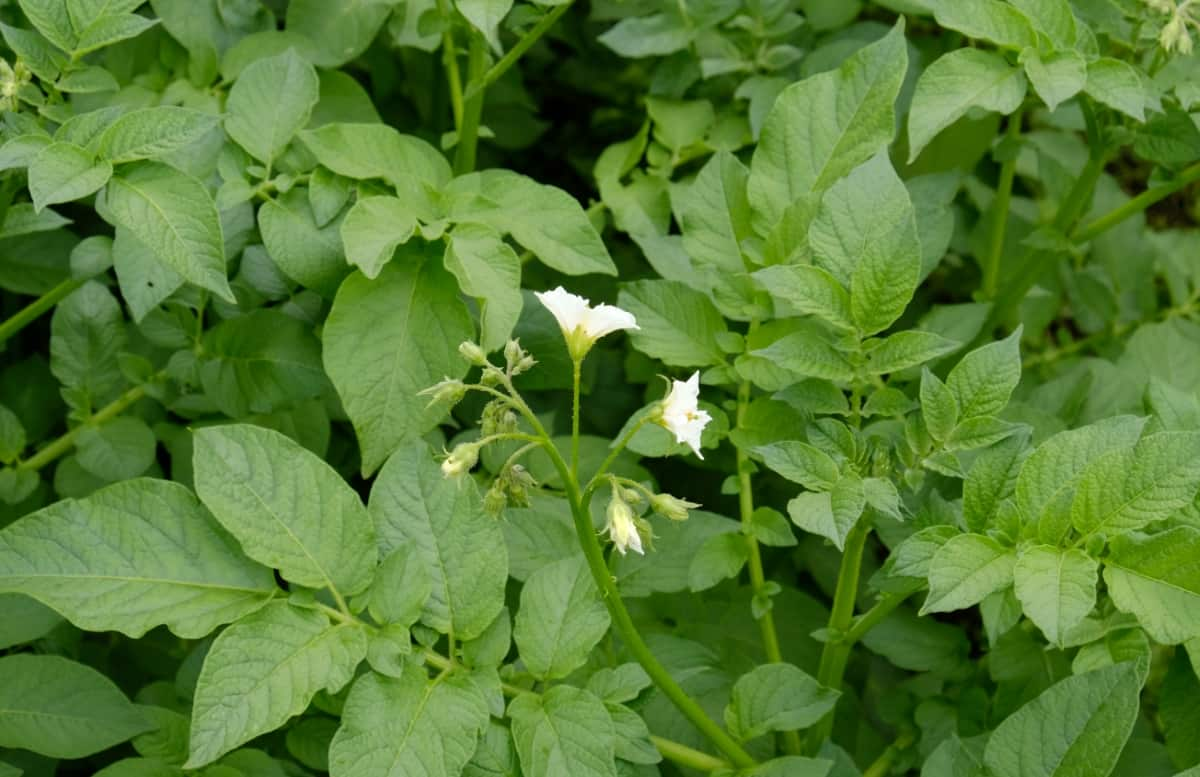Welcome to our comprehensive guide on growing hydroponic potatoes, where we demystify the art of cultivating this starchy delight without soil! Harnessing the power of hydroponics, we’ll show you a revolutionary way to produce healthy and delicious potatoes, no matter the space constraints. We’ll explore the ideal nutrient solutions, appropriate lighting, and pH levels.

How to Grow Hydroponic Potatoes
What are Hydroponic Potatoes?
Hydroponic potatoes are potatoes grown without soil in a nutrient-rich water solution. Instead of traditional farming, this method utilizes a controlled environment to deliver essential nutrients directly to the plants. This innovative approach optimizes potato growth, conserves water, and minimizes the need for pesticides. It is an efficient way to cultivate delicious potatoes in any space, from small containers to large hydroponic systems.
Hydroponic Potato Growing Techniques
Start with seed potatoes, preferably those with eyes, for better germination. Plant the seed potatoes about 1 inch deep and 6 inches apart in the chosen medium mixture under net pots to prevent floating. Cover the potatoes as they grow to protect them and maintain moisture. Soil-grown and hydroponic potatoes both require consistent coverage and nutrient supply. Growing hydroponic potatoes indoors provides environmental control, avoiding pests and ensuring optimal conditions.
LED or fluorescent grow lights mimic daylight, allowing year-round cultivation. While outdoor potatoes benefit from direct sunlight, hydroponic potatoes’ controlled conditions make indoor growing advantageous. Covering the potatoes as they grow is essential, as watering consistently but not excessively and providing a nutrient-rich solution. Flushing old solutions and replacing them with fresh ones ensures the potatoes receive the required nutrients.
Potato Cultivation in Hydroponics
A combination of perlite, vermiculite, and peat seed makes an ideal growing medium. Perlite enhances oxygen flow to the roots, while vermiculite helps retain moisture, which is vital for optimal potato growth. Peat seed offers support to mimic the earth’s nurturing effects. The choice of hydroponic system, whether a potato tower, large bucket, or bin, is up to the grower’s preference. Adequate drainage is essential, ensuring potatoes don’t sit in water. A simple hydroponics system can be set up using a 10-inch bucket with small holes drilled on the sides. The medium mixture should consist of perlite, vermiculite, and peat seed.
A Step-By-Step Guide to Growing Hydroponic Potatoes
Choose disease-free seed potatoes and maintain a clean environment. Opt for disease-resistant varieties like Red Pontiac. Ensure proper spacing for good air circulation and avoid overwatering. Consider using aquaponics for outdoor cultivation. The growth duration ranges from 70 to 90 days. Use a heavy perlite or vermiculite base as a growing medium. Monitor water quality and pH around 6. Provide 10-12 hours of light daily. Address any diseases promptly with natural remedies or approved treatments.
Best Nutrient Solutions for Hydroponic Potato Plants
Using a 20-20-20 water-soluble fertilizer with micronutrients weekly supports early growth. Once the plant reaches around 20 inches, switch to a 10-10-20 liquid potassium-rich fertilizer to encourage tuber development. Feeding the potatoes with nutrient-rich solutions at this stage ensures a successful harvest. Growing potatoes in a soil-free environment is achievable with the right approach. However, certain challenges need attention, like longer light cycles, proper water temperature (70-75°F), and pH level (6.0). Using vermiculite, peat, and perlite as the growing media yields the best results.
Optimal Lighting Conditions for Hydroponic Potato Growth
Two efficient hydroponic systems for potatoes are the Nutrient Film Technique (NFT) and Hydroponic Drip Irrigation. Both methods offer bountiful harvests, with the NFT allowing dry surfaces for tuber growth. Fingerling potatoes thrive in this system, with varieties like Bellanita and Norland maturing quickly. Preparing Seed potatoes, small tubers for planting can grow from pieces of store-bought potatoes. Cutting them into smaller pieces or using whole potatoes with multiple eyes maximizes yield.
In case you missed it: 8 Common Problems with Potato Plants: Treatment and Solutions

Maintaining pH Levels in Hydroponic Potato Systems
Maintain suitable temperature (68-75°F), lighting (10-12 hours), pH (5.8-6.2), and nutrient levels. Adequate spacing and disease control are essential for healthy potato growth. Popular potato varieties suitable for hydroponic cultivation include Accent, Gold Rush, Casablanca, Charlotte, Jazzy, Lady Christ, Red Pontiac, and Winston. Starting with sprouting potatoes from a nursery is recommended over store-bought ones treated with anti-sprouting agents. The growth period for hydroponic potatoes ranges from 70 to 90 days, depending on the species and the growing environment, significantly shorter than traditional soil-based cultivation.
Preventing and Treating Common Diseases in Hydroponic Potatoes
- Maintain a clean and controlled environment by starting with disease-free seed potatoes and sterilizing all equipment. Regularly monitor water quality and maintain a clean system.
- Choose resistant potato varieties like Red Pontiac to reduce infection risk.
- Ensure proper spacing between plants to improve air circulation and reduce humidity.
- Use a well-designed irrigation system for precise water delivery.
- Implement integrated pest control strategies to control pests that can transmit diseases.
- Early detect diseases by regularly inspecting plants for signs of wilting, discoloration, or unusual growth.
- Take swift action if diseases occur and remove affected plants immediately.
- Consider using natural remedies like neem oil or garlic-based sprays for mild infections.
- Apply approved fungicides or bactericides as directed, following safety guidelines.
- Properly dispose of infected plant material to prevent the disease from persisting.
Harvesting and Storing Hydroponically Grown Potatoes
For potatoes, a heavy perlite or vermiculite base is commonly used in hydroponic systems, along with peat, pebbles, and LECA. Providing sufficient nutrients is crucial for hydroponic potatoes, and a versatile base nutrient solution like MASTERBLEND allows for adjustments based on specific needs. Hydroponic potatoes generally require 10 to 12 hours of light daily for optimal growth, but they can survive for around 6 to 8 hours, depending on the species, and grow light power.
Troubleshooting Common Issues in Hydroponic Potato Cultivation
Hydroponic potatoes thrive at around 70 degrees Fahrenheit, making them well-suited for cool weather. The nutrient solution and medium should maintain a consistent 70-degree temperature to ensure optimal nutrient and oxygen intake. For the ideal environment, maintain the pH around 6 to create an acidic setting, beneficial for hydroponic potato growth.
Regularly monitor water levels, ensuring they touch the area where roots enter the water without submerging the whole seedling. Providing an ebb-and-flow system with 5-6 watering cycles of 10 minutes can enhance growth. While the initial setup cost of hydroponic systems may be a disadvantage, DIY options can be cost-effective. Hydroponic potatoes may yield less than field-grown ones but are free from soil-borne diseases and offer year-round harvest possibilities.
Maximizing Yield in Hydroponic Potato Farming
Hydroponic potatoes yield up to 1,200- 1,500% more than soil-grown potatoes, allowing year-round indoor cultivation.
In case you missed it: 10 Common Problems with Garden-grown Potatoes: Treatment and Solutions

Conclusion
Growing hydroponic potatoes is an efficient and rewarding endeavor. Using the right nutrient solutions, medium, lighting, proper care, and disease prevention, you can enjoy a bountiful harvest of delicious spuds in any space year round.
- Feed Your Flock for Less: Top 10 Tips to Save on Chicken Feed
- Ultimate Guide to Ossabaw Island Hog: Breeding, Raising, Diet, and Care
- Hatching Answers: The Top 10 Reasons Your Chickens Aren’t Laying Eggs
- Eggs and Economics: Breaking Down the Cost of Raising Backyard Chickens
- Defend Your Greens: Proven Methods to Keep Iguanas Out of Your Garden
- Ultimate Guide to Cinnamon Queen Chicken: A Comprehensive Guide for Beginners
- Ultimate Guide to California Tan Chicken: Breeding, Raising, Diet, Egg-Production and Care
- Ultimate Guide to Marsh Daisy Chicken: Breeding, Raising, Diet, and Care
- 10 Types of Chicken Farming Businesses You Can Start for Profits